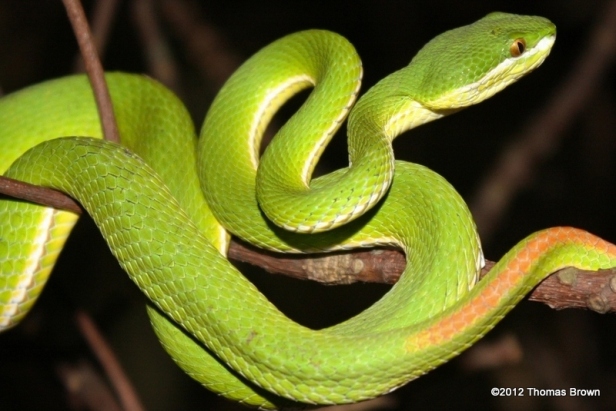Trimeresurus albolabris
Venomous and Dangerous!

|
|
|
|
|
|
|
|
|
English name: White-lipped Pit Viper (aka “White-lipped Tree Viper”, “Yellow-lipped Green Pit Viper”, “Bamboo Viper”)
Scientific name: Trimeresurus albolabris (formerly Cryptelytrops albolabris)
Thai name: Ngu Kieo Hang-mi Tong Loeng
Description: To 104cm long. A slender snake with a broad triangular head. Heat-sensing pits are located on the head between the nose and each eye. Body is green above and much paler green or yellowish below. Head is green above and the lips and throat are white, yellow, or pale green. Eyes are orangish-yellow. Tail is brown.
Similar Species: Large-eyed Pit Viper is blueish-green on the lips and throat and has a stouter head and larger eyes.
Mangrove Pit Viper is brown, gray, olive, or greenish-yellow and has dark blotches.
Golden Tree Snake has a narrower, non-triangular head and black markings.
Long-nosed Whip Snake is more slender and has a longer, narrower head that ends in a point.
Habitat: Can be found in forest, shrubland, plains, agricultural areas, and gardens. Usually found off the ground in trees or bushes.
Place in the ecosystem: Eats frogs and lizards, and occasionally small rodents and small birds as well. Is eaten by birds of prey and larger snakes.
Danger to humans: The White-lipped Pit Viper has a dangerous bite and should be taken seriously. Bites can result in intense pain, swelling, necrosis of flesh, and in some cases severe systemic bleeding. Fatalities are very rare but local damage can be lasting. Anyone who is bitten by a pit viper should be taken to the hospital as quickly as possible.
Conservation status and threats: No known conservation threats. Is widespread and can tolerate a range of habitats.
Interesting facts: Southeast Asian Pit Vipers are not as deadly as the local cobras, kraits, and true vipers, but still can do some damage. The White-lipped Pit Viper is the leading cause of snakebite-related hospitalization in Thailand, and along with the Large-eyed Pit Viper is responsible for 40% of all snakebite hospitalizations in the country.
Thailand’s pit vipers have a “hemorrhagic” venom that causes pain, swelling, coagulopathy, and some tissue damage. In serious cases severe coagulopathy, internal bleeding, and necrosis of the flesh can develop. Pit viper-specific antivenom is available and should be administered as soon as possible to relieve symptoms and decrease long-term effects.
If you or someone you are with is bitten by a White-lipped Pit Viper, the most important steps are to:
1) Keep the victim calm, having them lie down with the bite mark below the heart if possible.
2) Take a picture of the snake to confirm identification for the hospital.
3) Get the victim to a hospital immediately where professional treatment can take place and antivenom can be given.
References:
IUCN Redlist: Cryptelytrops albolabris
Severe coagulopathy associated with white-lipped green pit viper bite
A national hospital-based survey of snakes responsible for bites in Thailand
Queen Saovabha Memorial Institute: Snake Farm
Wikipedia: Trimeresurus albolabris
University of Hong Kong: Cryptelytrops albolabris
Ecology Asia: White-lipped Pit Viper
Snake Bites and their Treatment
A Photographic Guide to Snakes and Other Reptiles of Peninsular Malaysia, Singapore and Thailand
A Field Guide to the Reptiles of South-East Asia
Snakes of Thailand and their Husbandry








